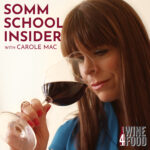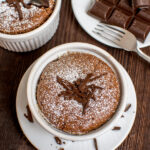
Wine and chocolate have many similarities but pairing them can yield differences of opinion. My palate was tested at a chocolate and wine tasting hosted by the Bordeaux Wine School led by Master of Wine Mary Gorman McAdams and Pierre-Antoine Bollet of La Maison du Chocolat. Like most food and wine pairings, they recommended comparing characteristics that complement each other. Bollet and McAdams outlined three considerations: structure (acidity, sweetness, astringency, tannins and alcohol), texture (delicate and light or rich and dense) and flavor (e.g., fruity, herbal, smoky, nutty, spicy and earthy). Other aspects include what’s added into the chocolate such as sea salt, nuts, espresso, mint, peanut butter, coconut, citrus, marzipan and fruit cremes.
Both chocolate and wine are fermented products that have tannins, acidity and texture and distinct flavor notes such as fruits, nuts, spice and herbs. “It’s about balancing qualities that complement rather than contrast. For example, pairing a sweeter chocolate with a drier wine will make the wine appear more bitter and acidic. A dark chocolate ganache will pair well with a dense, spicier red wine,” Bollet said. A surprise pairing for me at the tasting was a Clos Floridène, Graves Blanc 2016 with a dark chocolate laced with lemon crème; it was a crowd pleaser among the attendees.
Terroir and Tannins, Flavonoids and Polyphenols
The commonality between chocolate and wine goes deeper. Grape varieties and cacao beans are each driven by origin of place and terroir. Wine grapes are cultivated around the world in both cool and warm climates. Italy, France Spain, Argentina and the U.S.A. are the largest producers. Cacao beans thrive in tropical climates. Africa accounts for 71 percent of all production, followed by Latin America with 16 percent. While there are many varieties of grapes used to make wine, chocolate is made from four key different cacao beans. Forastero represents 80 percent of cultivation followed by Trinitario, 20 percent, and the rarer Criollo and Nacional. Both wine and chocolate can be designated single origin when from one region or from a single estate, and can be certified organic.

Dark chocolate must be a minimum of 43 percent cacao and milk chocolate a minimum of 30 percent cacao. White chocolate has no cocoa powder (a heated form of cacao) and is 20 percent cacao butter and 14 percent milk; experts do not consider it true chocolate.
Red wine and dark chocolate contain flavonoids and reseveratrol, types of polyphenols with high antioxidant potential to protect the body against free radicals, reduce low-density lipoprotein (LDL) cholesterol (aka “bad cholesterol’) and prevent blood clots and damage to blood vessels—all beneficial for maintaining a healthy heart. Chocolate and red wine are also reportedly aphrodisiacs, the latter especially for women according to a 2006 study by a group of Italian researchers. Both are also stimulants for other reasons; chocolate contains caffeine and wine has alcohol.
Bon Bons Away! Taste and Decide for Yourself
Forrest Gump said, “Life is like a box of chocolates. You never know what you’re gonna get.” I felt that sentiment at my local Hudson Valley chocolate shop, Krauses’s, selecting my box of assorted bon bons to taste with wines. Sitting down with a box of chocolates and tasting different wines is a fun way to spend an evening with friends. Everyone has a favorite and I asked around for recommendations. Red wine and chocolate came up frequently, but there were differences of opinion. Some wine professionals I spoke with felt the tannins in a red wine such as Cabernet are too bitter; yet others swoon over spicier Syrah and Zinfandel and chocolate.
Why stay monogamous to one style of wine? Chocolate marries well with many. Here are a few pleasurable pairings to try (those with links I tasted and recommend)
Dark Chocolates (bittersweet: 70-100% cacao, and semi-sweet: 50-60% cacao)
Dense rich chocolates have earthy notes with dark berries, spicy dried fruit and spice. Think about plush wines with concentrated fruits such as a velvety lush red such. Syrah, Zinfandel, Merlot, Cannonau di Sardegna or Barolo. Recommendations: Château Bourgneuf, Pomerol, 2015, Fratelli Puddi Tiscali Cannonnau di Sardegna 2014.
Fortified wines such as ruby port and oloroso sherry and a rich Pedro Ximénez work well as do brandies like cognac or Tariquet, 12 Year Folle Blanche, Cask Strength, Bas-Armagnac. Sweeter wines pairings include Banyuls (try: Domaine La Tour Vieille Banyuls Rimage, Mise Tardive 2016, Banyuls), Sauternes (Château de Cérons 2009) or a Passito (Donnafugata Ben Rye). I also enjoyed the spicy licorice, orange peel and herbal character of amaro like the sublime Amaro Nonino Quintessentia.
Milk Chocolates
These are creamier and sweeter chocolates with caramel, brown sugar and nutty aromas and flavors. While many of the wines listed above will work, such as brandies, banyuls and port, you can also go lighter and toastier. Recommendations: Graham’s 10 year Old Tawny Port and Sherry (Oloroso or crème). Also consider lush sweet wines like Sauternes, Château de Climens 2010, Barsac or Hungarian Tokaji, Disznoko Tokaji Aszu Five Puttonyos 2010.
Nuts, Toffees and Fruits
Also consider the fillings. Amontillado or Oloroso sherry and Madeira marry beautifully with toffee chocolate, nutty bon bons or a those with a hint of sea salt. Citrus creams like lemon or orange will appeal white wines like a Semillon or Viognier and sauternes. I enjoyed a dark chocolate with coconut with Yarden’s Golan Heights Winery Sauvignon Blanc 2018. Cherry cordials and raspberry cream-filled chocolates go with fruitier reds or a sparkling rosé like Lucien Albrecht Cremant d’Alsace.
White Chocolates
Go lighter and aromatic to capture the milky, honey character of white chocolates such as Pinot Gris, Reisling or Moscato d’Asti. (Try Michele Chiarlo Nivole Moscato d’Asti).
Champagne and Chocolate
Even though this pairing makes a romantic gift, opinions were mixed. A brut style of champagne can be too acidic. But the soft berry notes in a rosé champagne or sparkling wine, or a demi-sec work nicely, especially with chocolate covered strawberries. Give these a try: Charles Heidsieck Brut Rosê and Laurent Perrier Harmony Demi-Sec.

Melanie Young co-hosts the national weekly radio show, The Connected Table LIVE! Wednesdays 2 pm EST on W4CY Radio and podcast permanently to iHeart.com and the free iHeart App.



